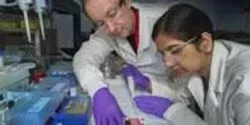Nanoparticles

Biological applications such as bioimaging, cancer treatment, tissue engineering and optical coding are just a few ways nanomaterials are being used in the lab today. Unfortunately, factors of nanoparticles, such as internal collisions with molecules, thermal motion, and gravitational forces affect the physical stability of nanoparticles making them difficult to work with in clinical applications or materials science.

The days of self-assembling nanoparticles taking hours to form a film over a microscopic-sized wafer are over. Researchers with the U.S. Department of Energy (DOE)’s Lawrence Berkeley National Laboratory (Berkeley Lab) have devised a technique whereby self-assembling nanoparticle arrays can form a highly ordered thin film over macroscopic distances in one minute.

For close to two decades, Cornell University scientists have developed processes for using polymers to self-assemble inorganic nanoparticles into porous structures that could revolutionize electronics, energy and more.

Clemson University researchers have developed nanoparticles that can deliver drugs targeting damaged arteries, a non-invasive method to fight heart disease.














